 |
6-29-4, All day today was in preparation to paint on the mural tomorrow morning. I've been wetting the the area since 8 AM. Picking the brushes, trowles, palettes laid out, stringing up the grid lines on the wall and in chalk on the acrylic color layout painting, Wetting and protecting lower faux marble with a cover, watching Maria Sharapova win her match at Wimbledon. This is the scaled acrylic paintIng I made for this mural. I chose the top morning scene. 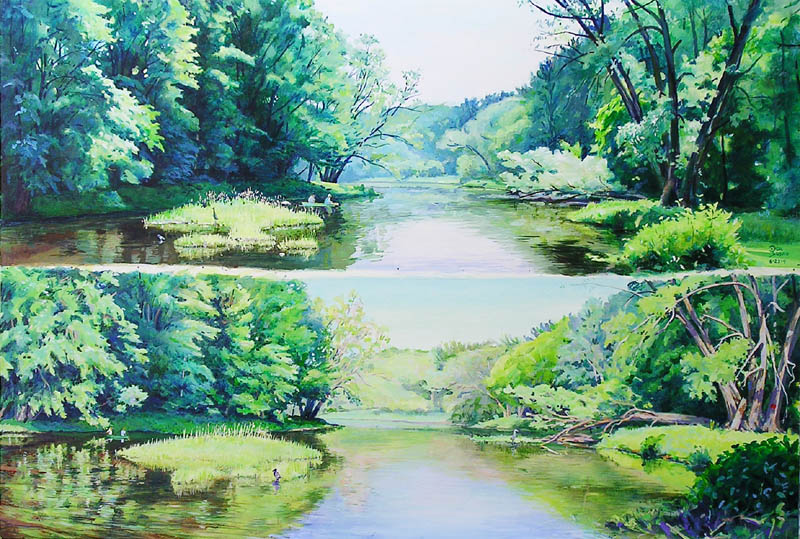 This will be a 3"x3" giornate using three transparent colors plus white. These are the primary transparent pigment colors that make a full color painting. Their mass colors match the transparent crystals of yellow, magenta and cyan including the way they become dark. These are the true transparent primary colors and the basis of the Real Color Wheel. Just as a note, PR122 quinacridone violet, is warmer than PR202 quinacridone magenta. Normally I use PR122 in acrylics and w/c but this is a cool mural and I have PR202 which is perfect to make great blues. The horizontal and vertical lines are strings, strung as the grid lines. With this grid I can transfer my acrylic paintings' chalk grid.
This is how I set up the string guides. 6-30-4, 10:45 AM, start laying intonaco mortar. On top of the wet Brown coat I put a thin wet intonaco slip coat on with a brush. Wash them in alcohol or vinegar to remove the lime. By the time this was finished it was ready for the full coat. I used my home made 12" plexie glass blade to smooth the surface. 12:20 AM, finished laying the intonaco mortar. I'll wait until after lunch before starting to paint. 2:10 PM, 100% coverage of color, I'm half way done.
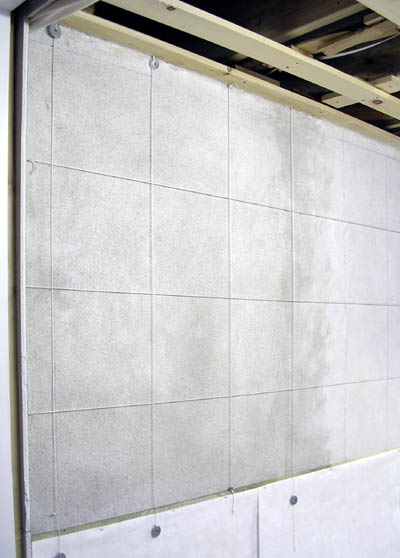
This is the clean giornate #1 with string grids and my transfered outlines.
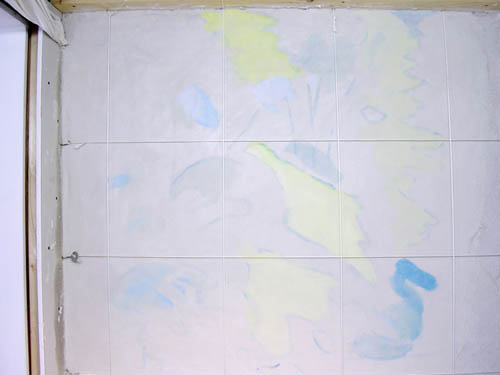

7-2-4, 9:30 AM, start laying giornate #2, Rub a loose slip thin layer of intonaco mortar on first with a brush dipped in lime water to soften the lime mortar. Spread the intonaco along the old edge first, get that good. Than spread the rest roughly, than a big float trowel or sponge to even it out, then a metal or plexie glass blade to make it ready for pigments. 11:10 AM, finished laying giornate #2. 11:30, Cut off the extra with a pointed trowel while the giornate is wet, so the edges will be smooth, clean off the extra so it won't fall on anything painted. Later I started using a "V" cut. Paint the connected edges first because they will dry out first. Second, cut the giornate lines 12:00 noon, painting 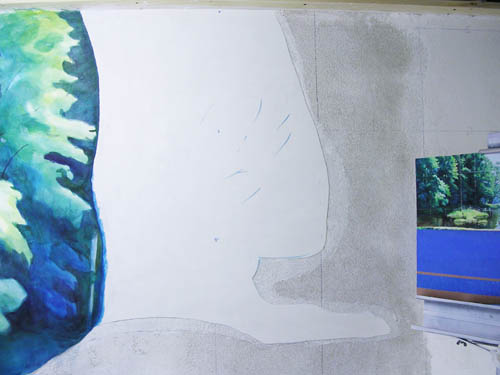
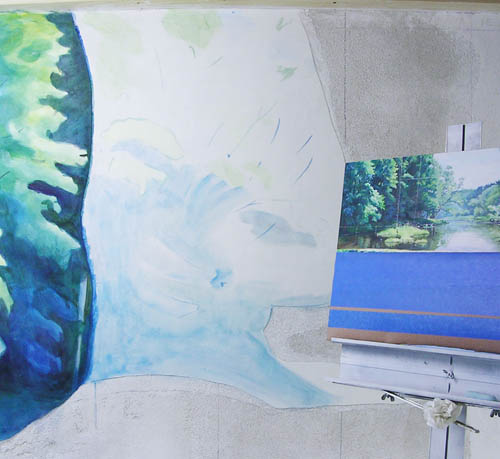
3:00 PM, I think it closed out but I'm not sure, three hours isn't enough. 4:30, Finished 2nd giornate. It's better to make a giornate cut along a pattern color edge than down the middle of a color pattern. Light colors are especially hard to match and the cut shows. I painted this giornate without my string guides, I made dots at all the corners, this was easier but not quite as accurate. The kayak is a paper cutout I could move into position. 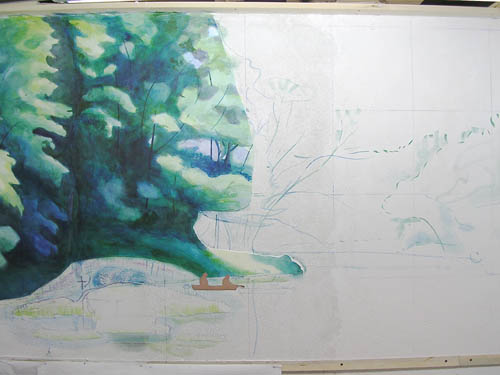
7-5-4, All day I've been drawing the cartoon. It's never ending.. I don't want to put 6M holes in it, I guess the spoon will have to do it's work and scribe in the lines as I go along. 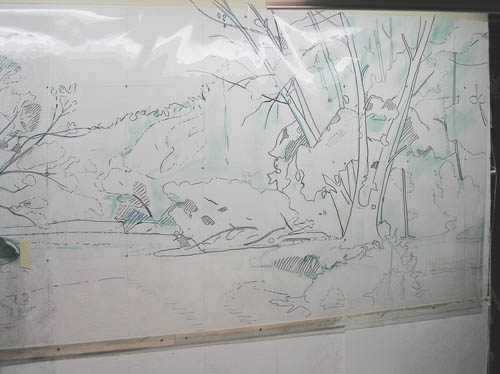
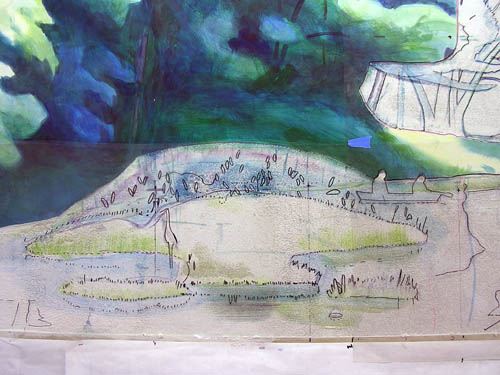
12:15 PM, finished laying #3. I'll let it set 10 minutes and really smooth it out. The transparent overlay is set and in place when the surface will just indent with finger tip pressure. About another 45 minutes. A spoon, a handle of a brush or a ballpoint pen. will scribe in the pattern outlines and giornate edges through the plastic. TIP: The following step will be to cut the giornate edges with a two stroke "V" cut and remove the excess mortar in the V. Do this before painting to insure against accidents. The intonaco is down, here shows the scribe lines and the cut being removed. 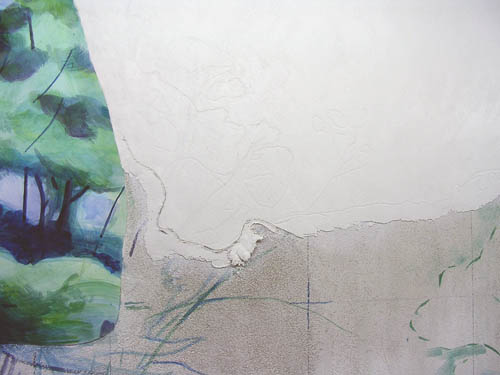
5:45, finished painting giornate #3, the sky is perfect. The delicate balance of cyan and magenta and yellow mixed with lime paste and titanium white made a beautiful sky of pink and blue. TIP: While I was making the pink color I put some of the color that was too intense but still made with lime paste on the dry brown coat wall below. Two hours later the color was locked onto the wall solid and insoluble. Lime paint has been around a long time, lime white-wash is what it was called, it was a house paint. The Egyptians added color to it. Secco painting needs a glue additive to adhere the pigment and a sealer. Contemporary was casein, egg yolk or lime. Techniques used by the ancients on dry walls include the 'Lost Art' of Cera Colla, which was both the glue and the gloss and made walls shine. 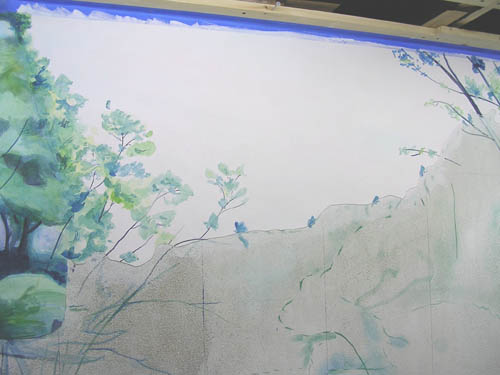
9:00 AM, wet the new wall in the morning until it holds a sheen. That took 2 hours by hand. Keep the forward and below areas wet with a spray bottle of lime water.

2:15 PM, finished laying #4 giornate with a flatter continuous beveled edge on the right and a 45 degree angle at the bottom. In this photo the test permanent pink hue made with lime on the dry brown coat can be seen. It is permanent. 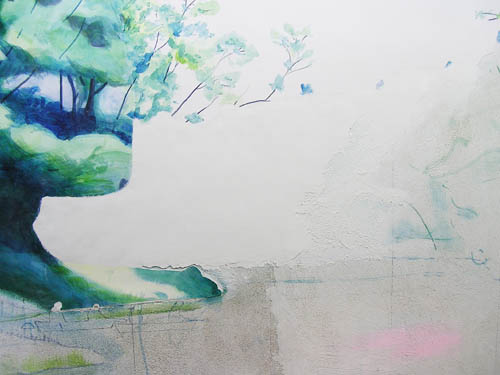
7:35 PM, I love the bristle brush, just like Steve on our fresco forum said. It's great.
Use a soft wash brush for dark colors. Do this first because it will take more than one wash. It's easy to paint light over dark when you mix lime paste into the lighter colors. TIP: Here is how I know what color a wet color with lime in it a will dry into.
I must say I'm using a lot of lime paste now that I'm confident that colors mixed with paste are permanent even if applied to mortar after it has set. That would be secco painting.
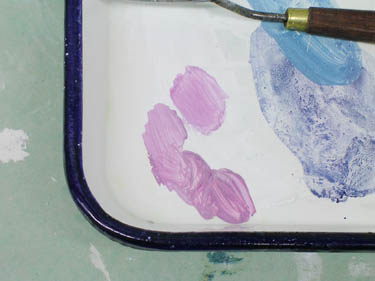 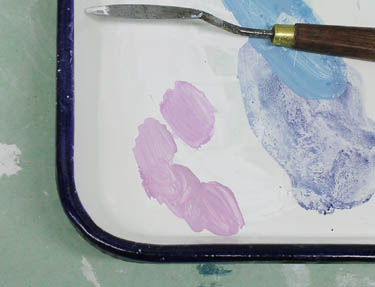
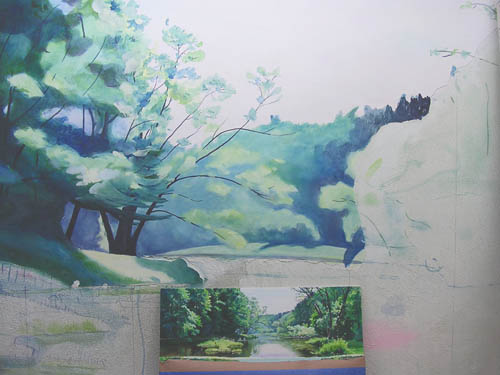
|
These links are to other 3 primary color paintings, the pigments are:
Dry Pigments;
Indian yellow PY153 from Zecchi,
Magenta PR122 from Sennelier,
Cyan PB15.3 from Senopia.
Food Coloring
The Easter Egg Coloring 6-pack.
Oil Paints,
Old Holland Indian Yellow Orange-side,
Daniel Smith Quinacridone Magenta PR122,
Grumbacher Thalo Blue, cyan PB15.3
Water Colors,
Daniel Smith New Gamboge PY153 Nickel Dioxine is the best Indian Yellow O/s pigment, bad name, good pigment.
Daniel Smith Quinacridone Magenta PR202 is more to the cyan side, bad choice.
I don't know why they won't use the most stable and magenta matching pigment PR122.
Grumbacher Thalo Crimson PV19 is more to the warm side, fugitive, bad choice.
Grumbacher Thalo Blue PB15.3
Children painting with Food Coloring Colors First Grade learning the primary colors.
Third grade art students using RCW primary colors
3 color examples Mixing the three transparent primary colors.
Lime Water Media 75 sq. foot Buon Fresco in 3 colors.
Lime Water Medium, Buon Fresco #1 in 3 colors.
Lime Water Medium, Buon Fresco #2 in 3 colors.
Hana Paintings with Maroger's Medium in 3 primary colors.
The Kaupo Hearts, Black Oil painting in 3 primary colors.
Egg Tempera Medium Still Life in 3 primary colors.
Water Color Painting with 3 primary colors.
Copal Medium with the RCW 3 Color Wheel
NEXT FRESCO PAGE, #53 Large mural continued, 2 of 4
PREVIOUS FRESCO PAGE, #51 Preparation for this mural
END PAGE Last Painting w/tips
VIEW THE PAINTING ON LOCATION COLOR FORUM FRESCO TOPIC
